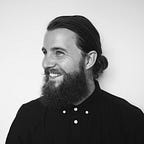Transitioning to working with a Designer
If you’re a Front-end Developer like me, odds are that you have (or believe you have) a few creative bones in your body. Since I started down the webby path many years ago my role has included both design and front-end extensively. I would typically be responsible for user journeys, wireframes, mock ups in Fireworks (Sketch more recently) and then bringing the creation to life in the browser with HTML, CSS and JavaScript.
I’ve read all the articles titled ‘should designers learn code’, (off topic, but in a nutshell I believe they should at least understand browser / code limitations) which had never really been an issue for me as I had always done both.
A few months ago I started working for Campaign Monitor, where they have a great set up. There are three main product teams comprised of a product manager, a designer, a front-end and 5 back-end developers. This makes for a mini-startup type feel which is a cool way of doing things.
My fears
I was initially a little bit worried as this spelled the end for my time putting mockups together – I felt like my job had been cut in half! I had a bunch of questions looping through my head:
- what if I didn’t like the designer’s work?
- what if they don’t understand limitations of code?
- what if I forget how to use Sketch?
- what if they just like to create beautiful images with no thought to the end user? I see examples of this on Dribbble all the time.
- and what if we hate each other?
Turns out, all my fears were unfounded. The designer I’ve been paired with is extremely talented and the product manager has made sure we’ve both been involved with putting together the user stories. Whilst the designer is without a doubt a pixel perfectionist, in many ways it takes the pressure off me as it means I have my own quality assurance before anything gets shipped. Things that I might previously have let slip under the radar now get picked up ensuring we have a better quality end product.
He also recognises that I had a design background and gets me involved early, asking for opinions and feedback, checking feasibility of different approaches. It has removed the rush factor from my work and stops me being a bottleneck that’s needed to both design and build a piece of UI.
We get on really well which is imperative when you’re working with someone so closely day to day. We’ve developed a solid working relationship and friendship, which makes it easy to discuss design decisions and be empathetic to each others point of view. Enabling these type of relationships to flourish is something that is at the heart of Campaign Monitor and we definitely benefit from ensuring all hires are a good culture fit.
Perhaps most importantly, this transition has allowed me to focus more on Front-end honing my skills specific to that area - with Service Worker, ES6 and React all on my learning list I think detailed visual design on top would be an overload.
Conclusion
It was definitely hard to let go of that part of my skill-set but I still do design on some of my side projects so I haven’t completely abandoned it.
As our Head of Engineering said in response to my ‘Is full stack a thing’ article, we want people with a T-shaped skill-set, and I’m now happy for design to form part of my top bar rather than my stem.
We’re currently looking for Front-end Developers in the San Francisco area so if it sounds like the sort of set up you’d be interested in, reach out :)
